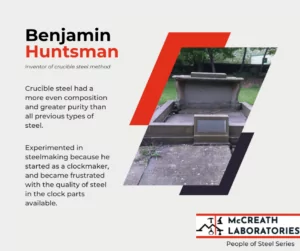Benjamin Huntsman
Inventor of Crucible Steel Method
(1740)
Benjamin Huntsman invented crucible steel with a more even composition and greater purity than previous methods. Huntsman began his career, in Doncaster, England, as a clock, tool, and lock maker and was frustrated by the quality of the German clock parts he was using. He began experimenting with steel in the 1740s and developed crucible cast steel in clay crucibles with added flux to draw out the impurities. He then moved his steelworks to Sheffield, England to have better access to raw materials.
Sheffield cutlery manufacturers refused to use Huntsman’s steel because it was harder than German steel, so he began exporting his steel to France. When French cutlery started impacting local cutlery sales, the local cutlers attempted to persuade the government to prohibit the exportation. Huntsman was secretive about his process and, lore says, became a target of industrial spies who bribed his employees and a rival named Walker even pretended to be a beggar, allowed to sleep by the fire in the works to gain information on his methods. There is even a story that Huntsman was the victim of France’s first industrial spy, metallurgist Gabriel Jars. Despite his stolen secrets, Huntsman’s business continued to thrive, and he expanded to a larger facility.
Benjamin Huntsman was a dedicated Quaker whose beliefs impacted his business decisions. He was secretive about his methods, but he did not patent his inventions because he didn’t want to attract attention. Huntsman was invited to join the Royal Society of London, a prestigious organization, but he felt it would conflict with his beliefs.
Although he was the target of industrial spies, Huntsman prospered until his death in 1776. His son and grandson continued working in the steel industry continuing the company through the 20th century, surviving bankruptcy. His son, William, focused more on button making while grandson Francis purchased surrounding real estate and invested in coal production.
Sources: https://www.quakersintheworld.org/quakers-in-action/288/Benjamin-Huntsman
https://www.britannica.com/biography/Benjamin-Huntsman
https://en.wikipedia.org/wiki/Benjamin_Huntsman
http://www.madehow.com/inventorbios/89/Benjamin-Huntsman.html
https://www.encyclopedia.com/science/encyclopedias-almanacs-transcripts-and-maps/benjamin-huntsman
https://link.springer.com/article/10.1557/mrs.2018.195
https://www.westyorkssteel.com/blog/steels-renaissance-man-benjamin-huntsman/
https://en.wikisource.org/wiki/Dictionary_of_National_Biography,_1885-1900/Huntsman,_Benjamin
https://www.dhi.ac.uk/huntsman/history_stage9.html
